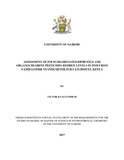| dc.description.abstract | On the Kenyan side of Lake Victoria lies its largest extension, Winam Gulf, averaging 10 meters in depth and covering area of 1350 km2. It drains to the open waters of the lake through Rusinga channel. The long rains season in the gulf is generally from March to May with November being the short rainy season, followed by the dry season. Nyando drainage basin has been divided into five main sub-catchment areas namely Nyando-Nandi, Nyando-Kericho, Awach-Kano and Nyando-Kano. It has been noted to be the most polluted drainage basin owing to the numerous farming activities and a wide range of pesticide application in farms along its banks.
This study aimed at determining the fish species of lower Nyando, correlating their occurrence to water quality parameters and quantifying the chemical pollution in the basin. In this regard, baseline data that can enable development of a monitoring plan for lower Nyando was generated. A total of 23 fish species from 5 orders and 7 families were collected from the thirteen sampling sites in the Nandi-Lower Nyando River sub-catchment. The family cyprinidae had the majority of the fish species (48%). Six major species were collected in the study sites and these included Barbus altianalis, Barbus nyanzae, Clarias gariepinus, Clarias leocephalus, Labeo victorianus and Oreochromis niloticus. Two indices were used in this study to give emphasis to the different aspects of diversity; the Shannon index that stresses the richness component and the Simpson index that lays greater emphasis on the evenness component. Sites are at the lower reaches of the river; Nyando at Dykes, Awach Kano and Ahero Irrigation Channel (Sites 17, 18 and 33), had the highest richness of species compared to sites in the middle reaches of the river; Ainopngetuny, Ainopisiwa and Kapngorium (Sites 22, 23 and 26). In general, the high diversity and richness sites are served with urban discharge and water from channels in the irrigated rice growing areas in Ahero and Awach Kano whereas the low diversity and richness sites are characterised by large scale coffee and sugarcane farming.
There was significant variation (𝑃 < 0.05) in most physico-chemical parameters between sampling sites in the four sampling periods as determined by one-way ANOVA. Correlation redundancy analysis (RDA) biplot showed a good relationship between fish species distribution and environmental variables. The most influential and explanatory environmental variables were altitude, temperature and dissolved oxygen concentration (DO). pH, TDS, turbidity, COD, BOD, temperature and phosphorus concentration positively influenced fish diversity. | en_US |



